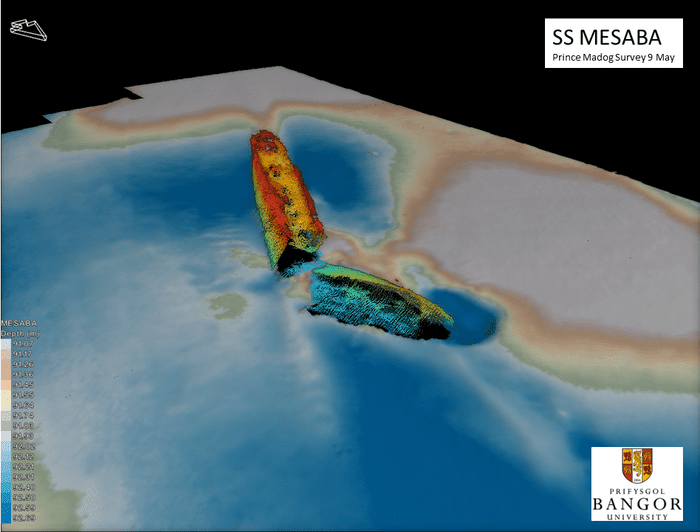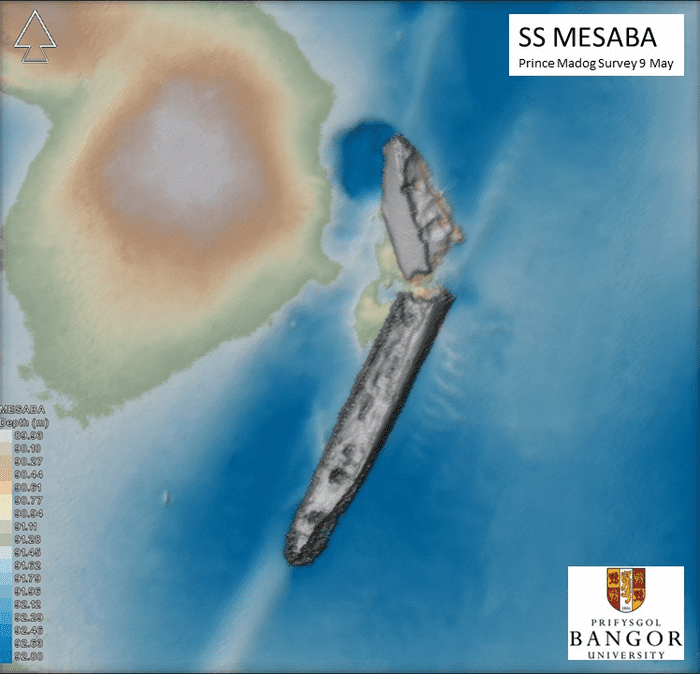Researchers at Bangor University have discovered the wreck of SS Mesaba, one of the ships that forewarned the Titanic of impending icebergs, growlers, and sea ice.

Back in April of 1912, as a party raged aboard the RMS Titanic, the ship’s radio operators received multiple warning messages that the sea ahead was perilous. Six other ships were navigating in the region, and their wireless sets were buzzing with warnings of ice on the water — beware! We all know that these messages were ignored, likely never making it to the Titanic’s commander from the radio cabin, and of the tragic fate that it was met with. But this story isn’t about the infamous liner — rather, it is a story about one of those six vessels that tried its best to prevent a tragedy.
This is the story of how the wreck of the merchant ship SS Mesaba was found over one century after being sunk by a German torpedo fired in anger.
In the Irish Sea
The SS Mesaba is only one of the 273 shipwrecks uncovered (and mostly identified) using state-of-the-art technology known as multibeam sonar in a 7,500-square-mile region of the Irish Sea. This area — the body of water stretching between the western coast of Ireland and the eastern coast of the British Isles — has been thoroughly navigated for centuries. It was also a hotbed of naval activity during both World Wars, a vital supply line between the United Kingdom, its overseas territories, and its other maritime partners; the bottom of the sea is thus littered with ships downed during these conflicts.
The SS Mesaba was one of them. SS Mesaba served as a merchant ship during the first World War, carrying much-needed cargo back and forth around the British Isles. In 1918, while part of a merchant convoy, it was targeted by a German submarine and hit with a torpedo amidships. The ferocious detonation broke her keel in two, sending the ship underwater.

Sonar (short for ‘sound navigation and ranging’) is by now a well-established tool for marine research and commercial maritime pursuits. It was first developed during World War I specifically to allow ships such as the SS Mesaba to detect and avoid submarines, and to allow submarines, in turn, to detect their targets. The most common type of sonar today, known as single-beam sonar, uses one transducer to emit acoustic signals whose echoes are then picked up to determine the direction and distance that a particular object sits from the transducer.
It works pretty much like a radar does, but with sound waves instead of radio waves.
Multibeam sonars, however, use several transducers in an array alongside appropriate sensors to pick up on their echoes. These arrays send out multiple simultaneous signals in a fan-shaped area instead of a single beam as traditional sonars do. By interpreting the echo the signals generate, the array can accurately measure the depth of the seafloor. As different materials interact in particular ways with sound, the intensity of the echo can be used to judge the nature of the materials that the sounds reflect off of. Put together, these two data streams allow multibeam sonar arrays to generate high-fidelity 2D or 3D maps visualizing the sea floor and any objects that rest upon it.

The discovery of the SS Mesaba and the other ships at the bottom of the Irish Sea — the wrecks of shipwrecks—trawlers, cargo vessels, submarines, and the largest ocean liners and tankers — were performed using such multibeam sonars.
The whole process, alongside the steps taken to have the ships identified by cross-referencing their dimensions and location against archival data of sunken ships, is detailed by Bangor University team member Innes McCartney in a new book titled Echoes of the Deep.
He describes the technology as a “game changer” for marine archaeology.
“Previously we would be able to dive to a few sites a year to visually identify wrecks,” he said in a press release. “The Prince Madog’s unique sonar capabilities has enabled us to develop a relatively low-cost means of examining the wrecks. We can connect this back to the historical information without costly physical interaction with each site. It should be of key interest to marine scientists, environmental agencies, hydrographers, heritage managers, maritime archaeologists, and historians.”









